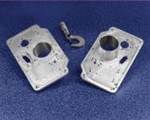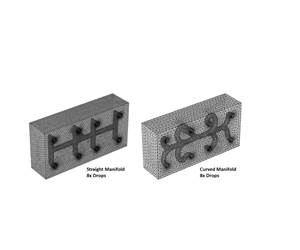Rapid Molds Produce One to Two Million Parts with a New Rapid Tooling Process
The capability of making a part using rapid tooling, as opposed to metal injection molds, dramatically reduces the time and money it takes to lead a product from the drawing board to market.
For a while, it seemed the phrase paradigm shift appeared way too often in literature and lexicon. Fortunately, the term has been used less since the meltdown in the dot.com world. But, leave it to the plastics industry to lead the way with a true resurrection of the word. Paradigm shift can be applied appropriately to a new method of creating plastic parts, blurring the distinction between prototyping and production runs - spawning a new term, ProDotyping.
By avoiding the expensive and time-consuming process of creating an injection mold, a new process and its associated machinery lowers plastics prototyping and production costs while dramatically speeding time-to-market.
Compcasting
This compcasting process enables the molding of fiber-reinforced Nylon 6 as easily as casting epoxy and urethane tooling plastics, using traditional low-cost, rapid tooling (RT) molds. Until now, the RT process has only been reserved for making prototype parts or models out of tooling plastics. Yet compcasting and its associated machinery, make it possible to go from a CAD file to creation of full-scale, production Nylon 6 parts in as little as a day. The significance of this new technology is that prototyping service bureaus can flow right into the production end of the market and manufacturers can produce very short runs if they so choose. For Nylon 6 applications, this is a major development. Unfortunately, there is a problem creating Nylon 6 parts using previous technologies. As one of the most common polymers used for fibers and in injection molding, Nylon 6 finds numerous applications in the automotive parts industry, such as intake manifolds, valve covers, water pumps, radiator fins and fan shrouds. It also is used for power tool handles, appliance parts and enclosures. However, as with most plastics, the creation of Nylon 6 production parts has traditionally begun with a trip to a rapid prototyping (RP) service bureau with a CAD file. These bureaus then translate the design file into a STL file and ultimately into one of the following prototype models: SLA, SLS, LOM or FDM.
Convinced with the potential of a prototype model, plastics manufacturers had to swallow hard and take the next big step: create an injection mold. For decades, plastics manufacturers have sought to find a way around commissioning these highly expensive dies that often represent a six-figure investment. For small or medium-sized manufacturers this cost was prohibitive.
These molds are understandably expensive because they must be designed to withstand extremely high pressures. With injection molding, plastic pellets are melted and forced under very high pressure into the die cavity. Once solidified, the properly shaped product is then de-molded.
In this manner, production quantities are achieved, but at quite a price in terms of cost and time. Plastic injection machines and their complicated ancillary systems such as hot runners (including nozzle tips, heaters, manifold thermocouples, piston and valve stem assemblies) are prohibitively expensive to purchase and maintain, putting them out of reach for smaller, start-up operations.
Clearly, the high cost for bringing new injection-molded products to market has limited the use and expansion of plastic parts. Even the alternative of metal RT (directly from a CAD file) has, until now, proved suitable only for small quantities of injection-molded parts.
Compcasting is a patented, rapid prototyping/production process for molding structural, fiber reinforced Nylon 6 and other thermoset resins. The equipment to implement this process is integral to the success of the compcasting process. It cannot be accomplished without the correct dispensing machinery. After obtaining the proper license and equipment, a plastics company or rapid prototyping service bureau can go from a CAD file directly to a fiber reinforced Nylon 6 structural production part. By using the compcast process, it can take as little as one day.
This quick turnaround begins with the building of a mold from a CAD file. A pattern is typically created (using SLA, SLS, FDM) in the same media traditionally used for casting urethane prototypes: rubber, plastic, plaster and sand. Even lost-core technologies using quick melting, eutectic alloy cores can be used due to the absence of high injection pressures when making the part.
PolymerizationM
The next step simply involves the traditional anionic polymerization method to manufacture fiber reinforced Nylon 6. A fiber reinforced Nylon 6 dispensing machine mixes the monomer caprolactam from which all Nylon 6 is manufactured with an activator. When the resultant slurry is heated to 140 to 150xC, fiberglass reinforcement then gets mixed in via the machine's agitator. To initiate polymerization and the part casting in one operation, the catalyst is dispensed from a separately heated tank. The catalyst is automatically injected, in the right proportion, into the stream of activated, fiber-reinforced caprolactam just prior to entering the mold.
As the materials are dispensed, gelation has already begun and the mixture thickens to denser slurry. Once in this state, the fiber reinforcement cannot fall out of suspension. The machine dispenses fiber-reinforced, Nylon 6 material directly into a mold, which has been preheated to a temperature of 140 to 150xC. The fiberglass-reinforced Nylon 6 then polymerizes into a structural part within seconds.
The flexibility of the process and the options available for the dispensing machine allows single dispensing units for one-off RP up to full-scale production part manufacturing.
In all cases, a single-cast fiber reinforced Nylon 6 part is identical in form, fit and function to a part manufactured in a production run, such as a high-pressure injection mold. Some industry experts believe that compcasted Nylon 6 can outperform injection-molded Nylon 66 parts in many applications.
Time and Money Savings
The capability of making a part using RT, as opposed to metal injection molds, dramatically reduces the time and money it takes to lead a product from the drawing board to market.
Using the Nylon 6 dispensing machine, rapid prototype and production molds can be created quickly, skipping the tremendous expense and typically long wait for the milling of metal injection dies. Additionally, rapid molds may now produce as many as one to two million Nylon 6 parts with compcasting.
The need for injection molding pellets also is eliminated with compcasting. In the case of fiber-reinforced Nylon 6, a preceding compounding step involves heating the Nylon until it is softened enough to where fiberglass can be added. This not only saves time, but also production costs. The compounder, who traditionally adds his fee, can be completely sidestepped.
Because of the efficiencies built into the compcasting machinery, the execution of production runs can take place at a more accelerated pace than injection machines. Since compcasting molds are significantly less expensive to make, it becomes far more cost-effective to have multiple molds with this process. As many as thirty duplicate molds can be set up on a single carousel while the dispensing machine continuously fills each mold as it passes the dispensing nozzle. With a shot size as large as one pound per second, and the ability to quickly feed multiple molds, even large production runs can be manufactured 60 percent faster over injection molding machinery.
The savings extends to cost-per-part, as well. At a minimum, molds can be developed at 80 to 90 percent of the steel die price. Additionally, compcasting machinery costs up to 66 percent less to purchase than heavy, high-pressure injection molding machines. In some applications, the overall compcast process has proven 50 percent less expensive than conventional injection molding - even in high production runs.
In many cases, the efficiencies and cost benefits afforded by compcasting can spell the difference between bringing a product to market and scrapping the project, especially when dealing with production quantities of less than one hundred thousand. In such relatively small quantities, the upfront cost of creating a robust, high-pressure injection die can sometimes never be amortized over the production run. In effect, this new ProDotyping way of doing business really has created a paradigm shift for those plastics manufacturers who wish to profit from innovation.
Related Content
From Injection Mold Venting to Runnerless Micro Molds: MMT's Top-Viewed June Content
The MoldMaking Technology team has compiled a list of the top-viewed June content based on analytics. This month, we covered an array of topics including injection mold venting, business strategies and runnerless micro molds. Take a look at what you might have missed!
Read MoreProducts and Services for Multiple Moldmaking Needs
New year, new technology roundup! Featured here is a collection of product offerings, from profile milling cutters to industry-specific CAD/CAM software to innovative hot work tool steels.
Read MoreMMT Chats: 4 Keys to a Successful Mold-Building Operation: Innovation, Transparency, Accessibility and Relationship
MoldMaking Technology Editorial Director Christina Fuges chats with Steve Michon, co-owner of Zero Tolerance in Clinton Township, Michigan, about the excitement of solving problems, the benefits of showing gratitude, the real struggle with delegation and the importance of staying on top of technology. This episode is brought to you by ISCAR with New Ideas for Machining Intelligently.
Read MoreGuidelines for Advanced Hot Runner Manifold Channel Design
Recent simulation research highlights the difference between a drilled, straight manifold channel design and a curved channel design produced via additive manufacturing.
Read MoreRead Next
Rapid Molding Process Provides Economic Alternative to CNC Machining of Components
A rapid casting process has been developed that serves as an economic alternative to CNC machining, die and investment casting, and sand casting with machining.
Read MoreHow to Use Continuing Education to Remain Competitive in Moldmaking
Continued training helps moldmakers make tooling decisions and properly use the latest cutting tool to efficiently machine high-quality molds.
Read MoreAre You a Moldmaker Considering 3D Printing? Consider the 3D Printing Workshop at NPE2024
Presentations will cover 3D printing for mold tooling, material innovation, product development, bridge production and full-scale, high-volume additive manufacturing.
Read More








_300x250 1.png;maxWidth=300;quality=90)

.jpg;maxWidth=300;quality=90)

















